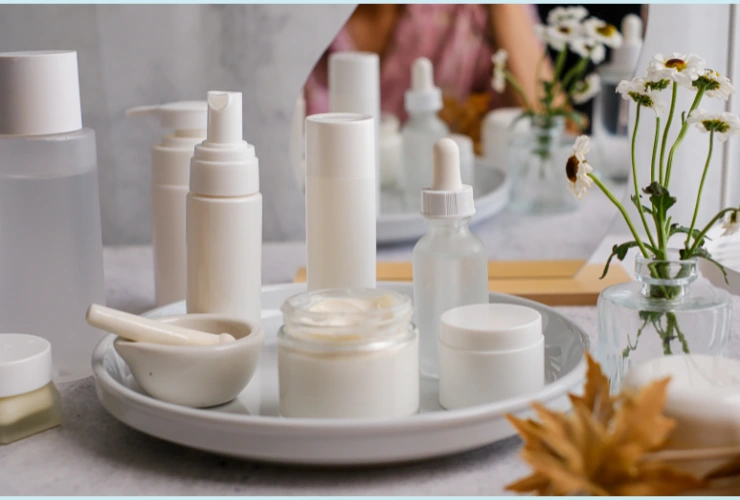Biotechnology in cosmetics is reshaping the beauty industry. By harnessing biological processes, we can now develop highly effective, sustainable and safe ingredients. From lab-grown actives to enzyme-based solutions, biotech opens new frontiers for innovation in skincare and personal care. In this article, we explore what cosmetic biotechnology is, the types of technologies used, and why more brands are embracing these advanced solutions to meet growing consumer demand for natural, science-backed products.

What is biotechnology in cosmetics?
Biotechnology in cosmetics refers to the application of biological systems, living organisms or derivatives to create cosmetic ingredients and products. It enables the development of actives that are both high-performance and aligned with sustainability goals—two priorities for today’s beauty industry.
Traditionally, cosmetic ingredients were extracted from plants or synthesised chemically. Biotech now offers a more controlled and efficient alternative. For example, using fermentation or cell cultures, we can “cultivate” molecules with superior purity, efficacy and consistency. This approach also helps reduce the environmental impact by limiting the need for harvesting natural resources.
The role of biotechnology is growing rapidly. Consumers increasingly seek products that are natural yet clinically proven. Biotech bridges this gap by delivering plant-based or marine-derived ingredients with optimised performance. In fact, many leading brands now rely on biotech innovations for anti-ageing, hydration, brightening and sensitive skin formulations.
Ultimately, biotechnology empowers cosmetic companies to “grow” ingredients to order—cultivating beauty solutions tailored to market needs. As regulatory frameworks evolve and new technologies emerge, biotech’s importance in cosmetics will only increase, driving the next generation of skin and haircare innovations.
Types of biotechnology used in cosmetics
The beauty industry leverages several branches of biotechnology to produce innovative cosmetic ingredients. Each offers distinct advantages, depending on the desired functionality and sustainability profile. Let’s explore the key types:
White biotechnology (industrial biotech)
This involves using fermentation processes—typically with bacteria, yeast or fungi—to produce active molecules. For example, hyaluronic acid, peptides or ceramides can be obtained through microbial fermentation in bioreactors. The result: high-purity, consistent ingredients produced without the limitations of traditional plant extraction.
Blue biotechnology (marine biotech)
Oceans offer a vast resource of bioactive compounds. Blue biotechnology focuses on cultivating marine organisms—such as algae, microalgae, seaweed or marine bacteria—in controlled environments. These organisms yield unique antioxidants, polysaccharides and other functional molecules ideal for anti-ageing, hydration and skin barrier support.
Plant biotechnology
Through plant cell cultures or tissue cultures, it’s possible to cultivate specific plant cells rich in desirable actives (e.g. polyphenols, flavonoids). This technique protects biodiversity, as small samples are sufficient to propagate the needed cells—without harvesting endangered species.
Enzyme technology
Enzymes are nature’s catalysts. Biotech enables the production of targeted enzymes (e.g. proteases, lipases, oxidoreductases) for applications such as gentle exfoliation, skin brightening, or sebum regulation. Enzymes offer a sustainable, skin-friendly alternative to harsher chemical ingredients.
Comparative table
| Biotech type | Source | Key applications in cosmetics |
| White biotechnology | Microorganisms (bacteria, yeast, fungi) | Anti-ageing actives, moisturisers, peptides |
| Blue biotechnology | Marine organisms (algae, bacteria) | Antioxidants, hydration, skin protection |
| Plant biotechnology | Plant cells and tissues | Antioxidants, skin brightening, soothing |
| Enzyme technology | Microbial fermentation or plant-derived | Exfoliation, brightening, acne care |
How biotech ingredients are produced: the process explained
Biotech beauty ingredients are the result of carefully designed and controlled bioprocesses. Much like cultivating precision crops, the goal is to “grow” functional molecules with optimised properties—ensuring quality, efficacy and sustainability.

The production process typically follows these key stages:
- Strain selection and optimisation
Biotechnologists select the most suitable microorganisms (e.g. bacteria, yeast, algae) or plant cells for the desired active compound. In some cases, synthetic biology allows further optimisation for higher yields or novel functionalities. - Laboratory cultivation
The selected strains or cells are cultured at laboratory scale. This stage allows researchers to fine-tune conditions (temperature, pH, nutrients) to maximise productivity and bioactivity. - Scaling up in bioreactors
Once optimised, the culture is transferred to bioreactors—controlled vessels that provide ideal growth environments at industrial scale. Depending on the ingredient, processes such as fermentation (for hyaluronic acid, peptides) or plant cell culture (for antioxidants, polyphenols) are used. - Harvesting and purification
After cultivation, the desired ingredients are carefully extracted and purified to meet cosmetic standards. Techniques such as filtration, centrifugation or chromatography ensure high purity and stability. - Formulation and testing
Finally, the biotech-derived ingredients are integrated into cosmetic formulations—creams, serums, cleansers—where their efficacy and safety are rigorously tested.
Key benefits of biotech beauty ingredients
Why are more beauty brands choosing biotechnology? Here are the key reasons:
- Superior efficacy
Biotech processes allow for precise control of active compound production. Result: ingredients with optimised concentration, stability and bioavailability—leading to visible, scientifically validated skin benefits. - Enhanced sustainability
By cultivating ingredients in bioreactors, biotech dramatically reduces land, water and energy use compared to traditional agriculture. It also protects biodiversity, as rare plants or marine species no longer need to be harvested. - High safety and purity
Biotech-derived actives are produced in sterile, controlled environments, ensuring minimal contamination and consistent quality—vital for sensitive skin formulations. - Continuous innovation
Biotech opens the door to novel molecules and functions that nature alone cannot provide. This fuels constant innovation in anti-ageing, skin regeneration, microbiome care and more. - Personalisation potential
With precision biotechnology, it’s possible to tailor ingredients for specific skin needs—laying the foundation for truly personalised beauty.
In short, biotechnology empowers us to “cultivate beauty solutions” with a level of precision, sustainability and creativity that traditional ingredient sourcing cannot match. It’s a game changer for the cosmetics industry—and one that’s only just beginning.
Real-world examples of biotech-based cosmetic products
Biotechnology is already powering some of the most innovative beauty products on the market. Let’s explore a few standout cases:
- L’Oréal uses biotech-derived hyaluronic acid, produced via microbial fermentation, across its premium skincare ranges—offering superior hydration and skin-plumping effects.
- Estée Lauder incorporates bio-fermented peptides in its serums to enhance skin firmness and repair.
- Biossance is a pioneer in squalane produced via sugarcane fermentation—an eco-friendly alternative to traditional shark-derived squalane.
- Seppic‘s CELTOSOME™ plant cell culture technology enables the production of rare plant actives without depleting biodiversity.
- Vytrus Biotech develops plant stem cell extracts for anti-ageing and skin-brightening applications.
These examples demonstrate how biotech empowers brands to create high-efficacy, sustainable and ethical ingredients—perfectly aligned with today’s beauty consumer expectations.

Challenges and considerations when using biotech ingredients
While the potential of biotech in cosmetics is immense, companies must also navigate certain challenges:
- Costs
Initial R&D and production costs for biotech ingredients can be higher than conventional ones, especially at small scale. However, costs tend to decrease as processes are optimised. - Stability
Some biotech-derived actives (e.g. enzymes, peptides) are sensitive to formulation conditions (pH, temperature). Careful formulation and encapsulation techniques are required to ensure efficacy over product shelf life. - Consumer perception
Despite the sustainability benefits, some consumers still associate “biotech” with “synthetic”. Clear communication is key—highlighting that these are nature-inspired, lab-cultivated ingredients. - Regulatory considerations
Biotech ingredients must comply with cosmetics regulations (EU Cosmetic Regulation, FDA, etc.). This includes demonstrating safety, purity and efficacy—requiring robust scientific data and documentation.
In short, integrating biotech into cosmetics requires expertise and strategic planning—but the rewards in terms of innovation and sustainability are well worth it.
Biotech vs traditional cosmetic ingredients: comparison table
Biotechnology is transforming cosmetic ingredient sourcing and development. But how do biotech ingredients compare to traditional ones? Here’s a clear overview:
| Aspect | Biotech Ingredients | Traditional Ingredients |
| Sourcing | Lab-grown via fermentation, cell culture, etc. | Extracted from plants/animals or synthetic |
| Sustainability | Low land, water and biodiversity impact | Often resource-intensive, risk of overharvesting |
| Batch consistency | Highly controlled, reproducible | Variable due to natural fluctuations |
| Efficacy | Enhanced potency via optimised bio-processes | Dependent on raw material quality |
| Safety and purity | High, with minimal contaminants | Risk of allergens, impurities |
| Innovation potential | Enables novel actives (e.g. lab-grown collagen) | Limited to what nature provides |
| Consumer perception | Growing interest, but some “synthetic” concerns | Perceived as “natural” but not always sustainable |
In short, biotechnology in cosmetics enables brands to “cultivate solutions to measure”, offering safer, more effective and sustainable ingredients—an increasingly attractive proposition for conscious consumers.
How to integrate biotechnology into your cosmetic formulations
Ready to explore biotech beauty? Here’s a practical step-by-step process for brands:
- Identify goals: What benefits do you want to offer? Anti-ageing? Skin barrier repair? Sustainability? Define your target claims.
- Scout biotech actives: Research biotech ingredients aligned with your goals—enzymes, peptides, polysaccharides, lab-grown lipids, plant stem cells… Engage with ingredient suppliers or biotech partners.
- Assess formulation compatibility: Work with your formulation team to test biotech actives for pH, temperature stability and interactions with other ingredients. Encapsulation techniques may enhance stability.
- Prototype development: Develop lab prototypes and perform efficacy tests (in vitro / ex vivo / clinical). Use iterative cycles to optimise concentration and formulation.
- Compliance check: Ensure the biotech ingredient meets cosmetic regulations (EU/UK/US). Gather safety dossiers and data required for product claims.
- Communicate clearly: Educate consumers about the benefits of biotech-derived ingredients—highlight sustainability, efficacy and ethical sourcing.
By following this roadmap, brands can successfully integrate biotechnology into cosmetics and deliver next-gen beauty products that resonate with today’s market.
The future of biotechnology in beauty
The future of beauty is undeniably biotech-driven. From lab-grown collagen to marine-derived actives and personalised skin microbiome solutions, biotechnology is reshaping cosmetics with unprecedented precision, efficacy and sustainability.
As consumers demand more ethical, high-performance products, brands embracing biotech will lead the next wave of innovation. At Cultiply, we’re excited to help partners cultivate breakthrough solutions—from lab to market—powering the beauty industry’s sustainable transformation.
















